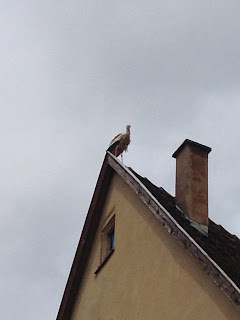For 15 days, I unplugged and tuned out, save
for a brief check-in at work and the odd news report that I'd accidentally run
across while trying to find the weather channel. We spent most of our time
touring the Old World, after all, and only a few intrusions from the
current one were welcome.
What you get out of the Old World is your
business. I was looking for a different Old World, not all that old, actually,
going only back to 1980, the last of the summer vacations in Germany I'd take
visiting our Oma in Hamburg. There was a large nostalgia component for me on
this trip, and even if I'd never been to the Black Forest (disputed by my
mother, btw) I was looking to recreate a few general memories. A summer lightning
storm, or a Capri Sonne after a long walk. Black bread and cheese for supper,
perhaps with a slice of Pflaumenkuchen. Black Forest cake at 3:00 in the
afternoon. All these were available and I hunted them down.
Indeed, the world lends itself to this repetition,
though not always in a good way. When I finally did plug myself back in to
current events, the top stories were:
gun violence in the US
soccer hooliganism
misery in Africa
tribal violence in Afghanistan
That last point was so evergreen, in fact, that
the BBC felt comfortable running stock footage from 1996 in the story, since no
current footage was available.
I have vivid memories of the German newspaper
the day Elvis died, back in 1977. This time around, it was Ali.
Ahh, you know, you can recreate certain
experiences, but ultimately, you can't go back again. Even if you tune the
world out, you carry much of it with you. Not the least of this was the two
kids I was toting along. Well. If I can't go back again myself, I can pay it
forward, so to speak. I'm pretty sure Holman will remember the cake from Cafe
Schnurr for years to come.
Anyway, to quote a recent movie I saw, there's
no ever after, only in between. So, let's run the numbers. In between
Day 0 and Day 15, the figures are:
Flight time (aggregate) 18 hours
Countries visited 3
Border crossings (excluding arrival) 11
Border crossing where we were stopped 1
Driving hours (approximate) 50
Driving kilometers (approximate) 2500
Wine consumed (approximate) 30 liters
Pretzels consumed 4
Of
which were sweet/fried 1
Schnitzels 12
Rösti portions 6
Spaetzle portions 8
Sausages 16
Asparagus Spears/soups 14
Crepes 4
Black Forest Cake (piece) 3
Pflaumenkuchen (piece) 1
Nesta’s Apple Tart (piece) 9
Schnappes 6
Rodelbahn rides 7
Gondola/Cable Car rides 0
Mountain Peaks trod 0
Castles visited 3
Of
which were ruins 2
Of
which were Neuschwanstein 0
Churches/Cathedrals visited 4
Of
which were ruins 1
Votive candles lit 6
Massages/mani-pedicures/spa/saunas 0
Swimming pool visits 2
Flea Markets 1
Chocolate factories 1
Cheese factories 0
Wineries visited 5
Of
which had a person there 1
Waterfalls visited 1
Waterfalls skipped 1
Aggregate Michelin stars in Baiersbronn 8
Michelin dining stars gathered 0
Boat rides 3
Garden Gnome sightings 9
Zeppelin sightings 2
Total Expenditures $$$$$.$$
Total Value
😄😄😄😄😄😄😄😄
There you have it, my loyal readers. I hope
you've had some fun reading my blog, I've certainly enjoyed writing it. I will
not shut down this blog completely, I'll have occasional updates on travel
topics as they arise. I expect our next trip to Europe will be some time away
-- we're more likely to take an extended domestic vacation next year. That has
planning implications of its own.

























































